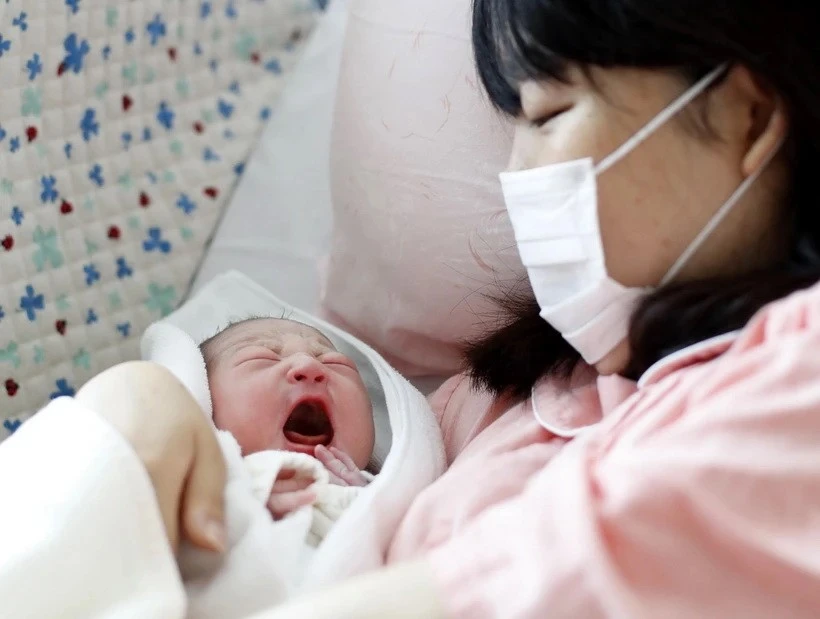Taking care of a newborn baby at a hospital in Toda, Saitama Prefecture, Japan. (Photo: Kyodo/VNA)
While many Western countries have fertility rates above 1.5, the severity of the situation in East Asia is striking. One reason is that the responsibilities of housework and child-rearing fall heavily on women.
According to a reporter in Tokyo, according to demographic statistics released on June 4, Japan's birth rate in 2024 is 1.15 - a record low for the third consecutive year. After hitting a bottom in 2005 at 1.26 and leveling off in 2022, the birth rate continues to decline with no signs of stopping.
The second baby boom generation (those who came of childbearing age in the late 1990s to early 2000s) was hit hard by the recession and the “job freeze.”
While women are increasingly participating in society, support policies such as developing the nursery system or maternity leave regime have not kept up.
Meanwhile, in South Korea, the fertility rate in 2024 is 0.75. Although it has increased slightly from 0.72 in 2023 due to an increase in the number of marriages, it is still the only country in the Organization for Economic Cooperation and Development (OECD) with a fertility rate below 1.0.
In South Korea, the burden of raising children is so great that many families only have one child. In 2022, the rate of first-born children will account for 57% of all births, the highest among OECD countries. Anxiety about the future makes many young people hesitate to marry.
South Korea’s new President Lee Jae-myung, who took office on June 4, made “10 major pledges” during his election campaign, including “gradually raising the age for child benefits to 18.” However, the population decline due to low birth rates is expected to continue.
According to the South Korean government 's estimates, the country's population in 2072 will be 36.22 million, down 30% compared to 2022.
In China, the birth rate is also slowing, with 9.54 million births expected in 2024, half the previous peak in 2016.
The “one-child” policy, which began in the 1980s, has led to a sharp decline in the number of women of childbearing age. Belief in education and the difficulty of finding jobs for young people have increasededucational competition. Similar to South Korea, the cost of education, such as private tutoring, has weighed heavily on families, leading many to believe that “one child is enough.”
The Chinese government proposed at the Two Sessions in March to gradually exempt tuition for preschool education such as kindergarten. A nationwide child-rearing subsidy is also being considered to ease the burden on families. However, it is unclear whether this will help stem the low birth rate.
Some common reasons why Japan, China and South Korea are all facing low birthrate crises include the economic hardship of young people and high housing prices in urban areas.
In addition, concerns about the cost of education and child-rearing are also a factor. Professor Masahiro Yamada (Chuo University, majoring in family sociology) pointed out: “In East Asia, there is a strong view that if you do not give your children a good education, you are not a valuable parent.”
In addition, the gender imbalance, where the burden of housework and childcare is heavily skewed toward women, is also believed to have a major impact. The World Economic Forum’s Gender Gap Index, published annually, shows that in 2024, Japan ranked 118 out of 146 countries, South Korea ranked 94, and China ranked 106, all at the low end.
Typically, in developed countries where gender equality is promoted, fertility rates are also higher. This is because men are more actively involved in housework and child-rearing, making it easier for women to balance work and family.
While most developed countries have faced falling fertility rates since the 1960s, Nordic countries such as France and Sweden have increased support for families with children, focusing on improving maternity leave and childcare services.
As a result, France reached a fertility rate of 2.0 in 2006, and Sweden surpassed the 1.9 mark in 2008. Although there has been a downward trend in recent years, these countries still maintain relatively high fertility rates compared to other developed countries./.
According to VNA
Source: https://baothanhhoa.vn/ty-suat-sinh-thap-bai-toan-nan-giai-cua-cac-nen-kinh-te-chau-a-251402.htm



























































































![[OCOP REVIEW] Tu Duyen Syrup - The essence of herbs from the mountains and forests of Nhu Thanh](https://vphoto.vietnam.vn/thumb/402x226/vietnam/resource/IMAGE/2025/6/5/58ca32fce4ec44039e444fbfae7e75ec)






Comment (0)